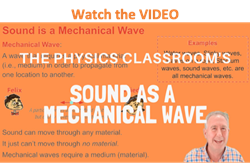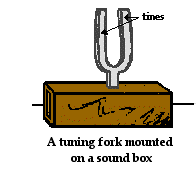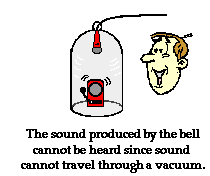Hold down the T key for 3 seconds to activate the audio accessibility mode, at which point you can click the K key to pause and resume audio. Useful for the Check Your Understanding and See Answers.
 Sound and music are parts of our everyday sensory experience. Just as humans have eyes for the detection of light and color, so we are equipped with ears for the detection of sound. We seldom take the time to ponder the characteristics and behaviors of sound and the mechanisms by which sounds are produced, propagated, and detected. The basis for an understanding of sound, music and hearing is the physics of waves. Sound is a wave that is created by vibrating objects and propagated through a medium from one location to another. In this unit, we will investigate the nature, properties and behaviors of sound waves and apply basic wave principles towards an understanding of music.
Sound and music are parts of our everyday sensory experience. Just as humans have eyes for the detection of light and color, so we are equipped with ears for the detection of sound. We seldom take the time to ponder the characteristics and behaviors of sound and the mechanisms by which sounds are produced, propagated, and detected. The basis for an understanding of sound, music and hearing is the physics of waves. Sound is a wave that is created by vibrating objects and propagated through a medium from one location to another. In this unit, we will investigate the nature, properties and behaviors of sound waves and apply basic wave principles towards an understanding of music.
As discussed in the previous unit of The Physics Classroom Tutorial, a wave can be described as a disturbance that travels through a medium, transporting energy from one location to another location. The medium is simply the material through which the disturbance is moving; it can be thought of as a series of interacting particles. The example of a slinky wave is often used to illustrate the nature of a wave. A disturbance is typically created within the slinky by the back and forth movement of the first coil of the slinky. The first coil becomes disturbed and begins to push or pull on the second coil. This push or pull on the second coil will displace the second coil from its equilibrium position. As the second coil becomes displaced, it begins to push or pull on the third coil; the push or pull on the third coil displaces it from its equilibrium position. As the third coil becomes displaced, it begins to push or pull on the fourth coil. This process continues in consecutive fashion, with each individual particle acting to displace the adjacent particle. Subsequently the disturbance travels through the slinky. As the disturbance moves from coil to coil, the energy that was originally introduced into the first coil is transported along the medium from one location to another.

A sound wave is similar in nature to a slinky wave for a variety of reasons. First, there is a medium that carries the disturbance from one location to another. Typically, this medium is air, though it could be any material such as water or steel. The medium is simply a series of interconnected and interacting particles. Second, there is an original source of the wave, some vibrating object capable of disturbing the first particle of the medium. The disturbance could be created by the vibrating vocal cords of a person, the vibrating string and soundboard of a guitar or violin, the vibrating tines of a tuning fork, or the vibrating diaphragm of a radio speaker. Third, the sound wave is transported from one location to another by means of particle-to-particle interaction. If the sound wave is moving through air, then as one air particle is displaced from its equilibrium position, it exerts a push or pull on its nearest neighbors, causing them to be displaced from their equilibrium position. This particle interaction continues throughout the entire medium, with each particle interacting and causing a disturbance of its nearest neighbors. Since a sound wave is a disturbance that is transported through a medium via the mechanism of particle-to-particle interaction, a sound wave is characterized as a mechanical wave.
Production and Propagation of Sound Waves
The creation and propagation of sound waves are often demonstrated in class through the use of a tuning fork. A tuning fork is a metal object consisting of two tines capable of vibrating if struck by a rubber hammer or mallet. As the tines of the tuning forks vibrate back and forth, they begin to disturb surrounding air molecules. These disturbances are passed on to adjacent air molecules by the mechanism of particle interaction. The motion of the disturbance, originating at the tines of the tuning fork and traveling through the medium (in this case, air) is what is referred to as a sound wave. The generation and propagation of a sound wave is demonstrated in the animation below.

 Many Physics demonstration tuning forks are mounted on a sound box. In such instances, the vibrating tuning fork, being connected to the sound box, sets the sound box into vibrational motion. In turn, the sound box, being connected to the air inside of it, sets the air inside of the sound box into vibrational motion. As the tines of the tuning fork, the structure of the sound box, and the air inside of the sound box begin vibrating at the same frequency, a louder sound is produced. In fact, the more particles that can be made to vibrate, the louder or more amplified the sound. This concept is often demonstrated by the placement of a vibrating tuning fork against the glass panel of an overhead projector or on the wooden door of a cabinet. The vibrating tuning fork sets the glass panel or wood door into vibrational motion and results in an amplified sound.
Many Physics demonstration tuning forks are mounted on a sound box. In such instances, the vibrating tuning fork, being connected to the sound box, sets the sound box into vibrational motion. In turn, the sound box, being connected to the air inside of it, sets the air inside of the sound box into vibrational motion. As the tines of the tuning fork, the structure of the sound box, and the air inside of the sound box begin vibrating at the same frequency, a louder sound is produced. In fact, the more particles that can be made to vibrate, the louder or more amplified the sound. This concept is often demonstrated by the placement of a vibrating tuning fork against the glass panel of an overhead projector or on the wooden door of a cabinet. The vibrating tuning fork sets the glass panel or wood door into vibrational motion and results in an amplified sound.
We know that a tuning fork is vibrating because we hear the sound that is produced by its vibration. Nonetheless, we do not actually visibly detect any vibrations of the tines. This is because the tines  are vibrating at a very high frequency. If the tuning fork that is being used corresponds to middle C on the piano keyboard, then the tines are vibrating at a frequency of 256 Hertz; that is, 256 vibrations per second. We are unable to visibly detect vibrations of such high frequency. A common physics demonstration involves slowing down the vibrations by through the use of a strobe light. If the strobe light puts out a flash of light at a frequency of 512 Hz (two times the frequency of the tuning fork), then the tuning fork can be observed to be moving in a back and forth motion. With the room darkened, the strobe would allow us to view the position of the tines two times during their vibrational cycle. Thus we would see the tines when they are displaced far to the left and again when they are displaced far to the right. This would be convincing proof that the tines of the tuning fork are indeed vibrating to produce sound.
are vibrating at a very high frequency. If the tuning fork that is being used corresponds to middle C on the piano keyboard, then the tines are vibrating at a frequency of 256 Hertz; that is, 256 vibrations per second. We are unable to visibly detect vibrations of such high frequency. A common physics demonstration involves slowing down the vibrations by through the use of a strobe light. If the strobe light puts out a flash of light at a frequency of 512 Hz (two times the frequency of the tuning fork), then the tuning fork can be observed to be moving in a back and forth motion. With the room darkened, the strobe would allow us to view the position of the tines two times during their vibrational cycle. Thus we would see the tines when they are displaced far to the left and again when they are displaced far to the right. This would be convincing proof that the tines of the tuning fork are indeed vibrating to produce sound.
In a previous unit of The Physics Classroom Tutorial, a distinction was made between two categories of waves: mechanical waves and electromagnetic waves. Electromagnetic waves are waves that have an electric  and magnetic nature and are capable of traveling through a vacuum. Electromagnetic waves do not require a medium in order to transport their energy. Mechanical waves are waves that require a medium in order to transport their energy from one location to another. Because mechanical waves rely on particle interaction in order to transport their energy, they cannot travel through regions of space that are void of particles. That is, mechanical waves cannot travel through a vacuum. This feature of mechanical waves is often demonstrated in a Physics class. A ringing bell is placed in a jar and air inside the jar is evacuated. Once air is removed from the jar, the sound of the ringing bell can no longer be heard. The clapper is seen striking the bell; but the sound that it produces cannot be heard because there are no particles inside of the jar to transport the disturbance through the vacuum. Sound is a mechanical wave and cannot travel through a vacuum.
and magnetic nature and are capable of traveling through a vacuum. Electromagnetic waves do not require a medium in order to transport their energy. Mechanical waves are waves that require a medium in order to transport their energy from one location to another. Because mechanical waves rely on particle interaction in order to transport their energy, they cannot travel through regions of space that are void of particles. That is, mechanical waves cannot travel through a vacuum. This feature of mechanical waves is often demonstrated in a Physics class. A ringing bell is placed in a jar and air inside the jar is evacuated. Once air is removed from the jar, the sound of the ringing bell can no longer be heard. The clapper is seen striking the bell; but the sound that it produces cannot be heard because there are no particles inside of the jar to transport the disturbance through the vacuum. Sound is a mechanical wave and cannot travel through a vacuum.
Check Your Understanding
1. A sound wave is different than a light wave in that a sound wave is
a. produced by an oscillating object and a light wave is not.
b. not capable of traveling through a vacuum.
c. not capable of diffracting and a light wave is.
d. capable of existing with a variety of frequencies and a light wave has a single frequency.